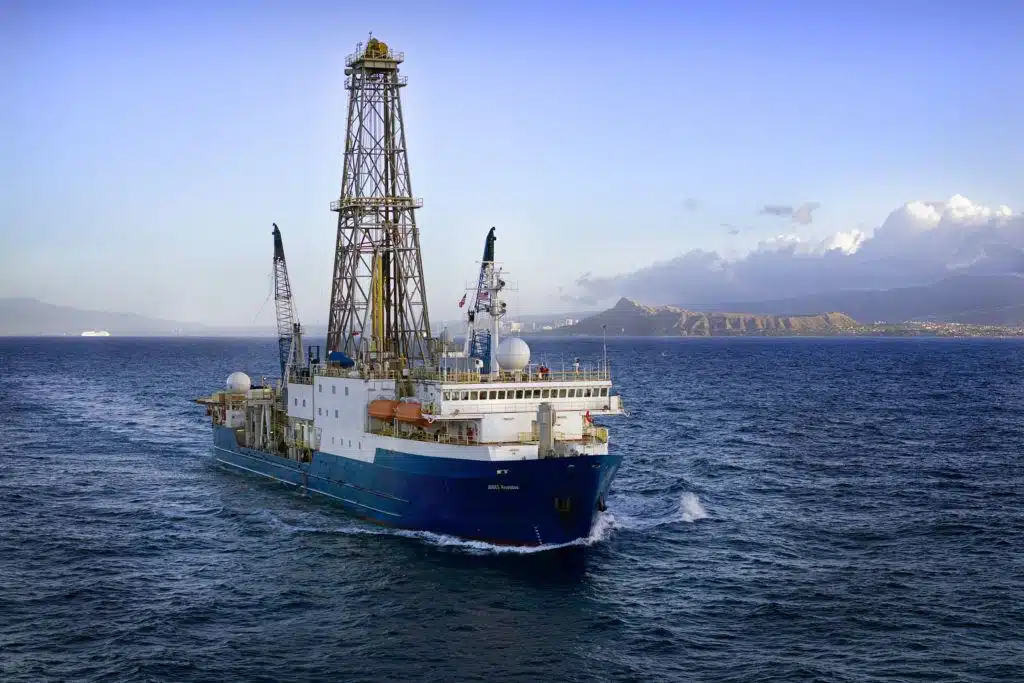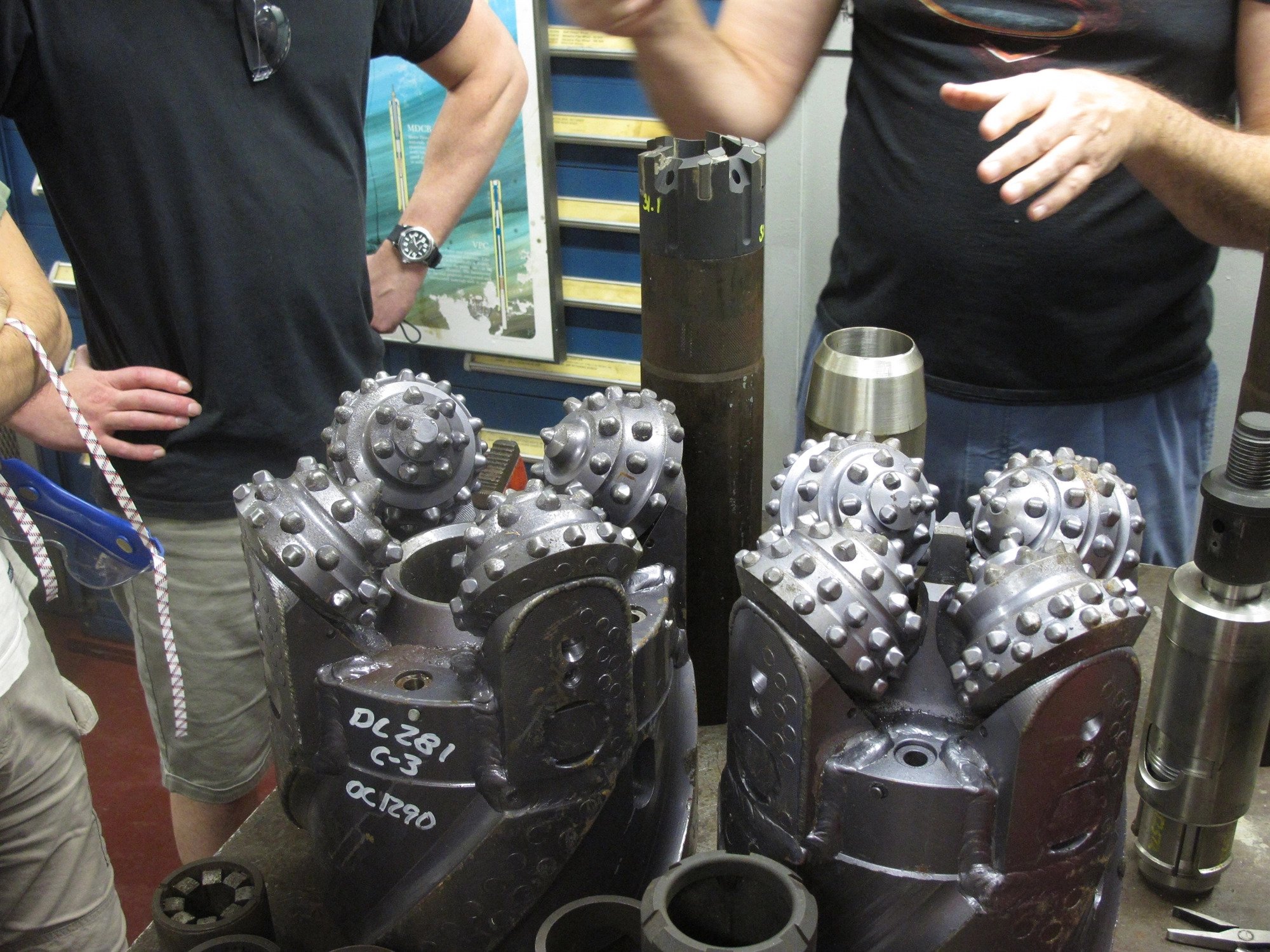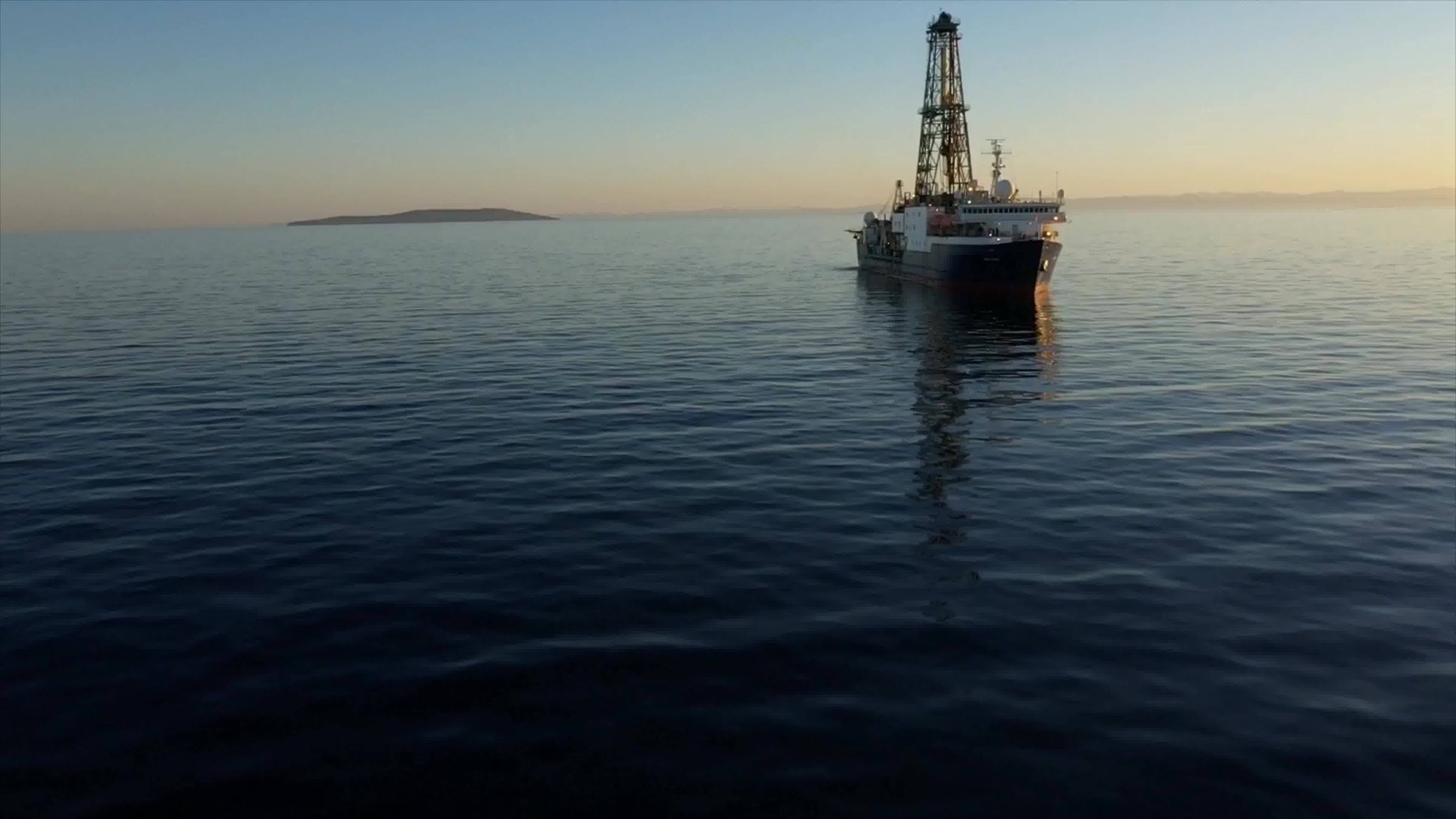
From mid-December 2022 to mid-February 2023 the largest US research vessel “JOIDES Resolution” will conduct offshore drilling around Santorini volcano.
The vessel will carry out six underwater drillings at depths never before explored. The goal is to reveal valuable information about the geological history of the volcanic complex of Christiana, Santorini and Kolumbo.
This volcanic field in the Aegean Sea is one of the most active volcano-tectonic lineaments in Europe. It is located in a 60-km-long, southwest-northeast–oriented rift zone and comprises the Christiana islets, the Santorini caldera, the submarine Kolumbo volcano, and the Kolumbo chain consisting of 24 submarine cones.
Christiana is a group of three volcanic Greek islets in the Cyclades. The group is located about 16 km (10 miles) southwest of Santorini, while Kolumbo is about 8 km (5 miles) northeast of Santorini’s Cape Kolumbo.
The purpose of the mission is to obtain geological information about the volcanic field. To achieve this, scientists plan to collect sediment cores through the volcanic layers of the seabed as part of the International Ocean Discovery Program (IODP).
The ship intend to depart from the Spanish port of Tarragona, in early December of 2022, and the scientists will continue their work until February 5, 2023.
Mission will be accompanied by a scientific exhibition
The first step of the mission is to inform the residents of Santorini and the wider public about its scientific objectives and IODP. To this end, the team is organising an interactive scientific exhibition entitled “Searching for the Secrets of Earth”.
The exhibition, with the support of the Municipality of Thira, will last from October 17 to 23. Scientists from the mission will be giving public lectures after. This will offer participants the opportunity to learn about the history and scientific goals of IODP as well as the research mission that will take place this winter. They can also take a virtual tour of the JOIDES Resolution research vessel to understand the geological history of the Santorini, Christiana and Kolumbo volcanoes.

During the week after the exhibition opening, residents and students from schools in Santorini and Thirasia will have the chance to visit the exhibition and learn about IODP, marine research andwhat scientists hope to learn from the sediments obtained. In addition, there will be able to see a 3D model of the seabed around Santorini and the opportunity to examine microfossil shells under a microscope.
Young enthusiasts can moreover take their own paper model of the ‘Joides Resolution’ as well to make at home. There will be change to speak with scientists participating in the expedition too, each one explaining his or her specialty (e.g. geologists, paleontologists, geophysicists, volcanologists, etc.). Furthermore, a large inflatable model of the US research vessel will also be waiting for students to explore.
According to Evi Nomikou, associate professor at the Department of Geology and Geo-environment of the University of Athens and participant in the scientific team of the research program said: ”Informing the local community is an important part of the mission.”
“Its goal is not only to solve questions about the ship that will be seen in their area in the coming days, but also to spread knowledge.”
Idea behind US research vessel’s drilling in Santorini volcano
The story of the mission began four years ago. A group of Greek and foreign scientists submitted to IODP a proposal for the realisation of underwater research drilling in the volcanic complex of Santorini. The IODP accepted the proposal and scientists are now ready to launch the mission.
The oceanographic expedition will take place with the research vessel “Joides Resolution” over a period of two months, from mid-December to mid-February”, stated Nomikou.
“The vessel will carry out six subsea drillings: two inside the Caldera at a depth of up to 360 meters from the bottom surface and another four at a depth of up to 860 meters: in the Christiana Islands, in the northwest side of the Kolumbo Volcano, in the Anafi Basin and in the Basin of Amorgos”.
US research vessel to obtain valuable evidence about Santorini volcano
The Santorini volcano has been studied by scientists since the 19th century. However, there are many questions still unanswered. Little information is also available about Greece’s Kolumbo volcano and the Christiana volcanic islets.
To give answers to the geological history of the volcanic field, each drilling will extract hundreds of meters of sediment from the seabed, which, in scientific terms, is called a ‘core’.
“Each layer of the seabed has a specific age and has come from a specific event. The advantage of studying underwater sediments is that they are undisturbed. They will reveal to us the geological history of the area,” explained Ms. Nomikou.

Answers to the Minoan eruption
Santorini was once home to a glorious Minoan civilization along the slopes of a volcano, with palatial homes, statuary, mosaics and paintings. However, it was destroyed by a volcanic event in the year 1650 BC.
The eruption of the island — which was originally called Stronghili, or “round” — decimated all life on the island and erased an entire city-state that was part of the Minoan civilization.
Ms. Nomikou highlights that the mission will give more insights on the Minoan eruption:
”We will be able to see how big the Minoan eruption was, since we will estimate the volume of volcanic material around Santorini, but also what was the order of the eruptions.”
She adds: ”We will study the history, dynamics and hazards of the undersea eruptions of Kameni and Kolumbo. There are many scientific questions we have, to which we hope we will get answers.”
Further understanding of the Christiana-Kolumbo volcanoes
Our understanding of the Christiana-Kolumbo volcanoes has so far been incomplete. The mission, therefore, seeks to offer scientists further understanding.
The active submarine volcano Kolumbo and the Christiana islets are part of the Santorini volcano. Kolumbo is located about 8 km northeast of Cape Kolumbo, Santorini island. The largest of a line of about twenty submarine volcanic cones extending to the northeast from Santorini. It’s about 3 km in diameter with a crater 1.5 km across.
The crater floor, in particular in its northern part, contains a large and very active high-temperature fumarole field. The crater of the volcano is a small caldera which could have been formed during the volcano’s only known, but very violent last eruption which occurred in 1650 AD.
The volcano was discovered when it breached the sea surface in 1649-50. The Smithsonian Institution’s Global Volcanism Program treats it as part of the Santorini volcano. However, other scientists maintain that it could be a separate magmatic system.
Christiana is a set of Greek islands in the Cyclades. They are uninhabited volcanic islets, about 10 miles southwest of Santorini. The cluster consists of three islands: Islet Christiani, is the northernmost of the cluster. It’s located 9 miles southwest of Accra Akrotiri on Santorini. Ascania, the second island is smaller than the previous. It’s located south-southeast. Finally, the Eschati island is the southernmost of the cluster.
Work at special laboratory
A team of 30 scientists aboard the research vessel will study each core the team manages to retrieve. The vessel has its own specialized laboratory aboard. There, scientists will analyse on a 24/7 basis the nuclei of sedimentary sampled from the sea bottom. This will allow them to reach scientific conclusions regarding how the eruptions in the past played out and how they might occur in the future.
“The results will come out before the mission is completed,” explains Ms. Nomikou.
Every mission which the US research vessel conducts is an investment of around €10 million. IODP covers the amount.
US research vessel to use innovative technology at Santorini volcano
According to Ms. Nomikou, the team will place robotic machines inside Kolumbo to monitor its activity in late November. What is more, research won’t limit itself to sediments.
“We have collected microbiological material, on which we performed DNA and RNA analyses. We are constantly learning about volcano bacteria in Kolumbo and Caldera,” adds Ms. Nomikou.
Santorini has a complex geological history. In recent decades, the University of Athens has been using innovative technologies in collaboration with leading foreign universities. Their aim was to reveal the geological history of the island’s volcano and assess its risk.
”We have not yet understood what is happening at great depth, we have mostly recorded the surface and still don’t know what the volcanic centers have to do with each other. Hopefully, we will get answers to some of these questions through the mission.”
The scientists from the mission want to be able not only understand what forces regulate the eruptions of the Santorini volcanic complex, but also to predict its future activity and widespread impacts.
See all the latest news from Greece and the world at Greekreporter.com. Contact our newsroom to report an update or send your story, photos and videos. Follow GR on Google News and subscribe here to our daily email!



